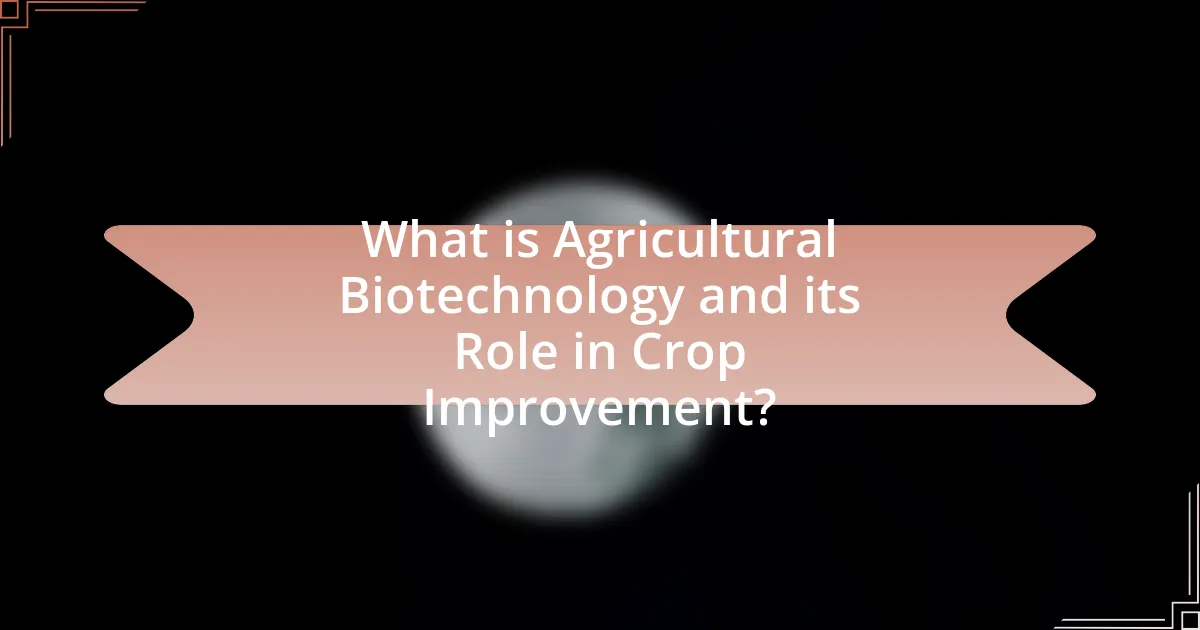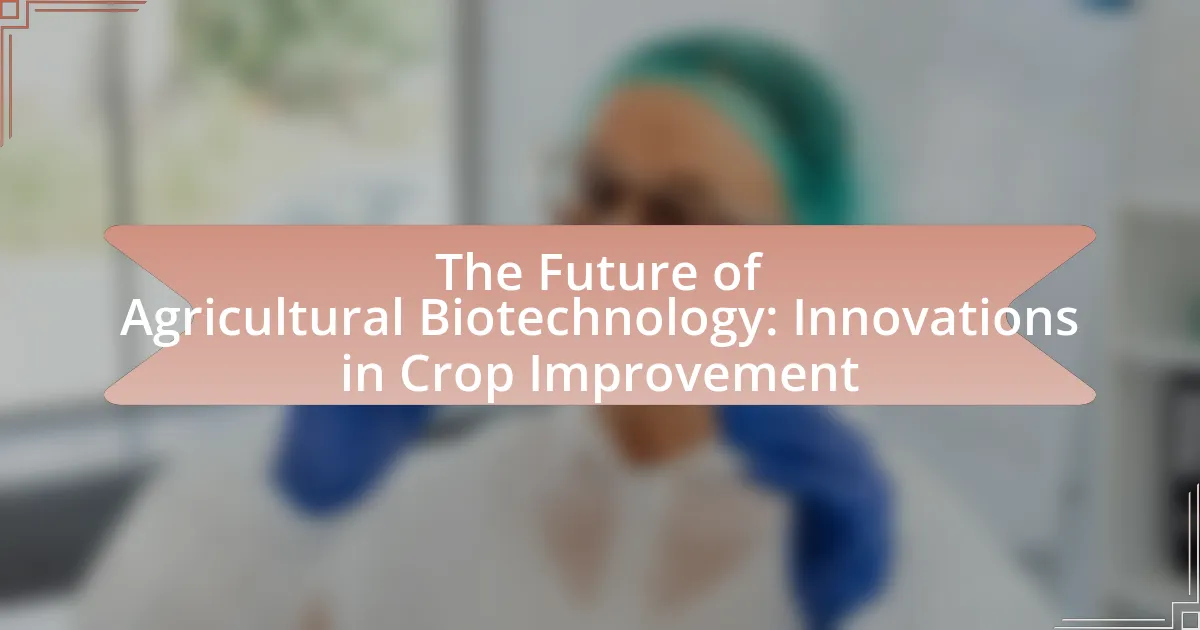Agricultural biotechnology is a scientific discipline focused on enhancing crop traits through biotechnological tools and techniques, leading to improved yield, pest resistance, and nutritional value. This article explores the role of agricultural biotechnology in crop improvement, highlighting its differences from traditional methods, commonly used techniques such as genetic engineering and CRISPR, and its significance for future food security amidst challenges like climate change and population growth. It also addresses ethical considerations, public perceptions, regulatory frameworks, and the economic advantages of biotechnologically improved crops, while discussing future trends and best practices for implementation.

What is Agricultural Biotechnology and its Role in Crop Improvement?
Agricultural biotechnology is a scientific field that utilizes biotechnological tools and techniques to enhance the genetic makeup of crops for improved traits such as yield, pest resistance, and nutritional value. This approach plays a crucial role in crop improvement by enabling the development of genetically modified organisms (GMOs) that can withstand environmental stresses, reduce reliance on chemical pesticides, and increase food security. For instance, the introduction of Bt cotton, which expresses a bacterial protein toxic to specific pests, has led to significant reductions in pesticide use and increased yields in various countries.
How does Agricultural Biotechnology differ from traditional methods?
Agricultural biotechnology differs from traditional methods primarily in its use of genetic engineering techniques to modify organisms at the molecular level. While traditional methods, such as selective breeding, rely on natural processes to enhance desirable traits over multiple generations, agricultural biotechnology allows for precise alterations of specific genes to achieve desired characteristics more rapidly and accurately. For instance, genetically modified organisms (GMOs) can be developed to exhibit traits such as pest resistance or drought tolerance in a single generation, whereas traditional breeding may take years or decades to achieve similar results. This precision in targeting specific genes is supported by advancements in molecular biology and genomics, which provide tools for identifying and manipulating genetic material effectively.
What techniques are commonly used in Agricultural Biotechnology?
Techniques commonly used in Agricultural Biotechnology include genetic engineering, tissue culture, molecular markers, and CRISPR-Cas9 technology. Genetic engineering allows for the direct manipulation of an organism’s DNA to introduce desirable traits, such as pest resistance or improved nutritional content. Tissue culture enables the propagation of plants under sterile conditions, facilitating the rapid multiplication of disease-free plants. Molecular markers assist in the identification of specific genes associated with traits, enhancing breeding efficiency. CRISPR-Cas9 technology provides a precise method for editing genes, allowing for targeted modifications that can improve crop resilience and yield. These techniques are validated by their widespread application in developing genetically modified organisms (GMOs) and improving crop varieties globally.
How do these techniques enhance crop traits?
Techniques in agricultural biotechnology enhance crop traits by enabling precise genetic modifications that improve yield, resistance to pests, and adaptability to environmental stresses. For instance, CRISPR technology allows for targeted edits in the plant genome, resulting in crops that can withstand drought conditions or resist diseases, which is evidenced by the development of drought-tolerant maize varieties that have shown a 20% increase in yield under water-limited conditions. Additionally, marker-assisted selection accelerates the breeding process by identifying desirable traits more efficiently, leading to the rapid development of improved crop varieties.
Why is Agricultural Biotechnology important for future food security?
Agricultural biotechnology is crucial for future food security because it enhances crop yields, improves nutritional content, and increases resistance to pests and diseases. By utilizing genetic modification and other biotechnological methods, crops can be engineered to withstand environmental stresses such as drought and extreme temperatures, which are becoming more prevalent due to climate change. For instance, genetically modified crops like Bt cotton and Bt corn have shown significant yield increases and reduced pesticide use, leading to more sustainable farming practices. According to the International Service for the Acquisition of Agri-biotech Applications, the global area planted with biotech crops reached 191.7 million hectares in 2018, demonstrating their growing importance in meeting the food demands of a rising global population.
What challenges does the global food supply face?
The global food supply faces significant challenges, including climate change, population growth, and resource scarcity. Climate change leads to unpredictable weather patterns, affecting crop yields and food production. According to the Intergovernmental Panel on Climate Change (IPCC), agricultural productivity could decline by up to 30% by 2050 due to rising temperatures and extreme weather events. Population growth, projected to reach nearly 10 billion by 2050, increases the demand for food, putting additional pressure on agricultural systems. Furthermore, resource scarcity, particularly water and arable land, complicates food production; the Food and Agriculture Organization (FAO) estimates that global water demand for agriculture will increase by 20% by 2050, exacerbating competition for limited resources. These interconnected challenges threaten the stability and sustainability of the global food supply.
How can Agricultural Biotechnology address these challenges?
Agricultural biotechnology can address challenges such as food security, climate change, and pest resistance by developing genetically modified crops that enhance yield, resilience, and nutritional value. For instance, crops engineered for drought tolerance can maintain productivity under water-scarce conditions, which is crucial as climate change intensifies. Research shows that genetically modified crops have increased yields by an average of 22% while reducing pesticide use by 37%, according to a study published in “Nature Biotechnology” by Klümper and Qaim in 2014. This demonstrates that agricultural biotechnology not only improves crop performance but also contributes to sustainable farming practices.
What are the ethical considerations surrounding Agricultural Biotechnology?
The ethical considerations surrounding Agricultural Biotechnology include concerns about environmental impact, food safety, and socio-economic effects. Environmental impact arises from potential biodiversity loss and the risk of genetically modified organisms (GMOs) escaping into wild populations, which can disrupt ecosystems. Food safety concerns focus on the long-term health effects of consuming genetically modified foods, with studies indicating that while GMOs are generally considered safe, ongoing monitoring is essential. Socio-economic effects involve issues of equity, as smallholder farmers may struggle to access biotechnology advancements, potentially widening the gap between wealthy and poor agricultural producers. These considerations highlight the need for responsible governance and public engagement in the development and deployment of agricultural biotechnologies.
How do public perceptions influence the adoption of biotechnological innovations?
Public perceptions significantly influence the adoption of biotechnological innovations by shaping consumer acceptance and regulatory policies. When the public views biotechnology positively, it leads to increased demand for biotechnological products, as evidenced by surveys indicating that 70% of consumers are more likely to purchase genetically modified organisms (GMOs) if they believe they are safe and beneficial. Conversely, negative perceptions, often fueled by misinformation or ethical concerns, can result in resistance to adoption, as seen in regions where public opposition has led to stricter regulations or bans on GMOs. This dynamic illustrates that public sentiment directly impacts the market viability and regulatory landscape for biotechnological innovations in agriculture.
What regulations govern the use of Agricultural Biotechnology?
The regulations governing the use of Agricultural Biotechnology primarily include the Coordinated Framework for the Regulation of Biotechnology, which was established by the U.S. government in 1986. This framework involves multiple federal agencies, including the USDA, EPA, and FDA, each responsible for different aspects of biotechnology regulation. The USDA oversees the environmental safety of genetically engineered organisms, the EPA regulates the use of pesticides and their effects on the environment, and the FDA ensures the safety of food products derived from biotechnology. These agencies work together to assess the risks and benefits of agricultural biotechnology, ensuring compliance with safety standards and environmental protection laws.
How is Agricultural Biotechnology evolving with new innovations?
Agricultural biotechnology is evolving through innovations such as CRISPR gene editing, which allows for precise modifications in crop genomes to enhance traits like drought resistance and pest tolerance. This technology has been validated by studies showing that CRISPR can increase yields by up to 20% in certain crops, demonstrating its effectiveness in improving agricultural productivity. Additionally, advancements in synthetic biology are enabling the development of crops with improved nutritional profiles, as seen in biofortified varieties of rice and maize. These innovations are supported by regulatory frameworks that are increasingly accommodating to biotechnological advancements, facilitating faster adoption and commercialization of new crop varieties.
What are the latest advancements in crop improvement through Biotechnology?
Recent advancements in crop improvement through biotechnology include the development of CRISPR gene-editing technology, which allows for precise modifications in plant genomes to enhance traits such as drought resistance and pest tolerance. For instance, researchers have successfully used CRISPR to create rice varieties that can withstand flooding, improving yield stability in flood-prone areas. Additionally, advancements in synthetic biology have enabled the engineering of crops with improved nutritional profiles, such as biofortified crops rich in vitamins and minerals. These innovations are supported by studies demonstrating increased agricultural productivity and resilience, highlighting the potential of biotechnology to address food security challenges.
How do CRISPR and gene editing technologies impact crop development?
CRISPR and gene editing technologies significantly enhance crop development by enabling precise modifications to plant genomes, which can lead to improved traits such as disease resistance, drought tolerance, and increased yield. For instance, research published in Nature Biotechnology demonstrates that CRISPR can be used to edit genes responsible for disease susceptibility in crops like rice, resulting in varieties that are more resilient to pathogens. This targeted approach reduces the time and cost associated with traditional breeding methods, allowing for faster development of improved crop varieties that can better meet global food demands.
What role do bioinformatics and data analysis play in crop improvement?
Bioinformatics and data analysis are crucial in crop improvement as they enable the identification of genetic traits associated with desirable agricultural characteristics. These tools facilitate the analysis of large genomic datasets, allowing researchers to pinpoint specific genes linked to traits such as drought resistance, pest tolerance, and yield enhancement. For instance, the use of genome-wide association studies (GWAS) has led to the discovery of genetic markers that can be used in breeding programs to select superior crop varieties more efficiently. Additionally, bioinformatics tools streamline the integration of phenotypic data with genomic information, enhancing the predictive accuracy of breeding outcomes. This integration has been shown to accelerate the development of improved crop varieties, ultimately contributing to food security and sustainable agricultural practices.
What are the potential benefits of these innovations for farmers and consumers?
Innovations in agricultural biotechnology provide significant benefits for farmers and consumers by enhancing crop yields, improving resistance to pests and diseases, and increasing nutritional value. For farmers, these advancements lead to reduced costs and increased productivity; for instance, genetically modified crops can yield up to 30% more than traditional varieties, according to a study by the National Academy of Sciences. Consumers benefit from improved food security and access to healthier food options, as crops can be engineered to contain higher levels of essential nutrients, addressing malnutrition issues in various populations.
How can Agricultural Biotechnology improve crop yield and resilience?
Agricultural biotechnology can improve crop yield and resilience by utilizing genetic modification techniques to enhance desirable traits in plants. These techniques allow for the introduction of specific genes that confer resistance to pests, diseases, and environmental stresses such as drought or salinity. For instance, genetically modified crops like Bt cotton and Bt corn have been shown to increase yields by reducing losses from insect pests, with studies indicating yield increases of up to 20% in some regions. Additionally, biotechnology enables the development of crops that can thrive in suboptimal conditions, thereby improving food security in areas affected by climate change. Research published in the journal “Nature Biotechnology” highlights that biotechnology can significantly contribute to sustainable agricultural practices by increasing productivity while minimizing the need for chemical inputs.
What economic advantages do biotechnologically improved crops offer?
Biotechnologically improved crops offer significant economic advantages, including increased yield, reduced production costs, and enhanced marketability. These crops often exhibit traits such as pest resistance and drought tolerance, which lead to higher productivity per acre. For instance, studies have shown that genetically modified (GM) crops can increase yields by 20-30% compared to conventional varieties. Additionally, the reduction in pesticide use associated with pest-resistant crops can lower production costs by up to 50%. Furthermore, crops engineered for specific traits can command higher prices in the market, enhancing profitability for farmers. These economic benefits are supported by data from the National Academy of Sciences, which indicates that the adoption of biotechnology in agriculture has contributed to a significant increase in global food production efficiency.
What are the future trends in Agricultural Biotechnology?
Future trends in agricultural biotechnology include the development of gene editing technologies, such as CRISPR, which enable precise modifications to crop genomes for improved traits. These advancements facilitate the creation of crops that are more resistant to pests, diseases, and environmental stresses, thereby enhancing food security. Additionally, the integration of biotechnology with data analytics and artificial intelligence is expected to optimize crop management practices, leading to increased yields and resource efficiency. According to a report by the International Service for the Acquisition of Agri-biotech Applications (ISAAA), the global area planted with biotech crops reached 191.7 million hectares in 2019, indicating a growing acceptance and reliance on these technologies in agriculture.
How might climate change influence the direction of Agricultural Biotechnology?
Climate change is likely to drive Agricultural Biotechnology towards the development of crops that are more resilient to extreme weather conditions. As global temperatures rise and weather patterns become more unpredictable, the need for genetically modified organisms (GMOs) that can withstand drought, flooding, and temperature fluctuations will increase. For instance, research indicates that crops engineered for drought tolerance can significantly improve yields in arid regions, which are becoming more prevalent due to climate change. Additionally, biotechnology may focus on enhancing nutrient use efficiency in plants, allowing them to thrive in less-than-ideal soil conditions, thereby ensuring food security in a changing climate.
What role will sustainable practices play in future innovations?
Sustainable practices will be integral to future innovations in agricultural biotechnology by driving the development of environmentally friendly and resource-efficient crop improvement methods. These practices promote the use of renewable resources, reduce chemical inputs, and enhance biodiversity, which are essential for addressing global challenges such as climate change and food security. For instance, the adoption of precision agriculture technologies, which optimize resource use and minimize waste, exemplifies how sustainability can lead to increased crop yields while preserving ecosystems. Additionally, research indicates that sustainable practices can improve soil health and resilience, further supporting long-term agricultural productivity (Source: “Sustainable Agriculture: A Global Perspective,” by Smith et al., 2021).
What best practices should be followed when implementing Agricultural Biotechnology?
Best practices for implementing Agricultural Biotechnology include conducting thorough risk assessments, ensuring regulatory compliance, engaging stakeholders, and promoting transparency. Risk assessments identify potential environmental and health impacts, which is crucial for responsible innovation. Regulatory compliance ensures that biotechnological products meet safety and efficacy standards, as seen in the rigorous approval processes in countries like the United States and the European Union. Engaging stakeholders, including farmers, consumers, and policymakers, fosters trust and acceptance of biotechnological advancements. Transparency in research and development processes enhances public understanding and mitigates misinformation, as demonstrated by successful public outreach initiatives in various agricultural biotechnology projects.


